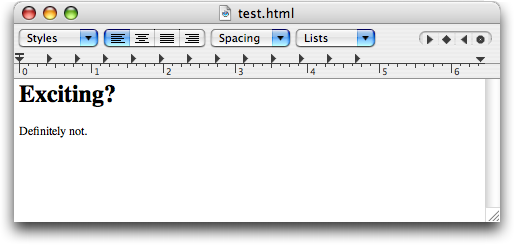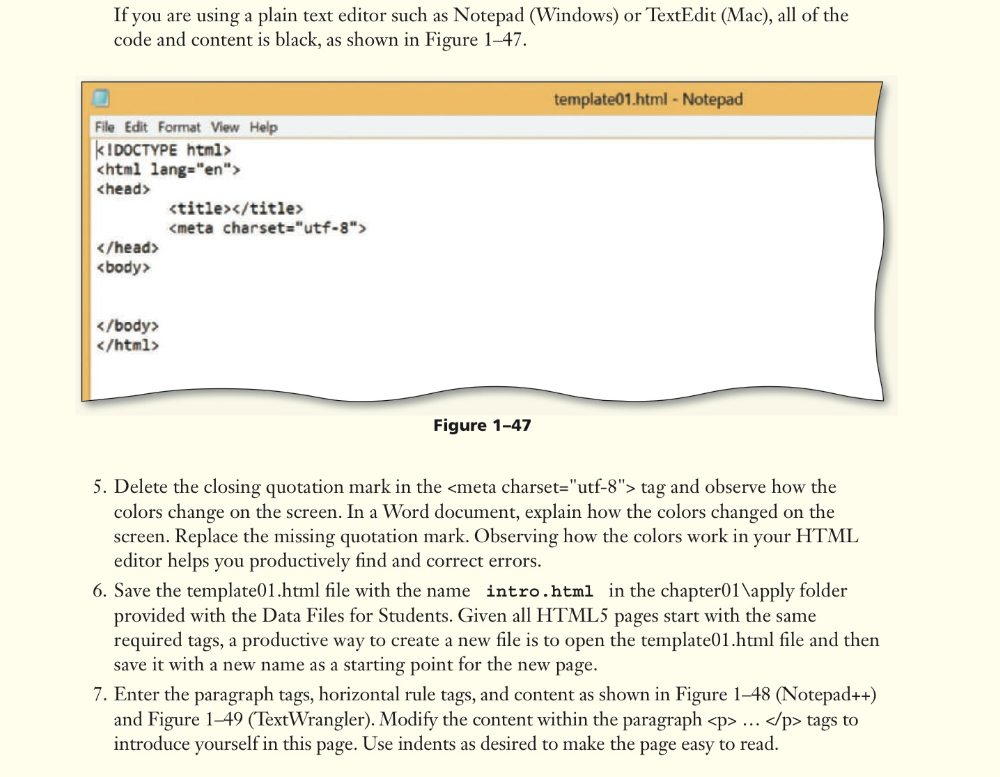Installation package: html-notepad.dmg (4,826 KB) Linux (requires GTK 3) Portable executable: html-notepad-dist.tar.gz (4,281 KB) – unpack the tarball in some folder and run html-notepad from there. You may need to adjust permissions of binaries. Question: Q: is there a notepad equivalent for mac More Less. Notepad is widely considered to be the best text editor available anywhere right now; there are people who have used it for more than ten years and who have never found a need to. Notepad 7.9: Stand with Hong Kong Notepad 7.8.9: Stand with Hong Kong Notepad 7.8.8 release Notepad 7.8.7 release. Notepad is a free (as in 'free speech' and also as in 'free beer') source code editor and Notepad replacement that supports several languages. Running in the MS Windows environment, its use is governed by GNU General Public License.
TextEdit User Guide
You can use TextEdit to edit or display HTML documents as you'd see them in a browser (images may not appear), or in code-editing mode.
Note: By default, curly quotes and em dashes are substituted for straight quotes and hyphens when editing HTML as formatted text. (Code-editing mode uses straight quotes and hyphens.) To learn how to change this preference, see New Document options.
Create an HTML file


In the TextEdit app on your Mac, choose File > New, then choose Format > Make Plain Text.
Enter the HTML code.
Choose File > Save, type a name followed by the extension .html (for example, enter index.html), then click Save.
When prompted about the extension to use, click 'Use .html.'
View an HTML document
In the TextEdit app on your Mac, choose File > Open, then select the document.
Click Options at the bottom of the TextEdit dialog, then select 'Ignore rich text commands.'
Click Open.
Always open HTML files in code-editing mode
In the TextEdit app on your Mac, choose TextEdit > Preferences, then click Open and Save.
Select 'Display HTML files as HTML code instead of formatted text.'
Change how HTML files are saved
Set preferences that affect how HTML files are saved in TextEdit.
In the TextEdit app on your Mac, choose TextEdit > Preferences, then click Open and Save.
Below HTML Saving Options, choose a document type, a style setting for CSS, and an encoding.
Select 'Preserve white space' to include code that preserves blank areas in documents.
Steam mac games list. If you open an HTML file and don't see the code, TextEdit is displaying the file the same way a browser would (as formatted text).
It is a WYSIWYG editor of structured documents: texts that have hierarchical and semantically meaningful (oxymoron, no?) structure: headers, list, plaintext islands, tables and so on.
Best Notepad For Mac
HTML-NOTEPAD is not a 'web page editor'. Don't even expect to create 'cool web pages' with it. With modern CSS, WYSIWYG Web design is simply impossible. Web pages are crafted manually by editing CSS, that is by nature of CSS.
But still HTML-NOTEPAD can be useful for Web designers too – for the cases when we need to create textual (yet structural) content of our pages. This very article I am editing in HTML-NOTEPAD:
Xml Notepad For Mac
HTML-NOTEPAD uses Sciter Engine for its UI. That means it is small, fast, does not have external dependencies and works on all major desktop operating systems: Windows (from XP to 10), Mac OS and Linux.
And exactly in the same way:

Yet HTML-NOTEPAD supports 'day' and 'night' editing modes:
To support keys-only editing as much as possible:
- All frequent editing actions are doubled by shortcuts. For example
CTRL+NUMPAD2will convert the paragraph intoelement. - 'Magic sequences' are in place. For example typing
*and{space}at the beginning of paragraph will morph it into bullet list (elements );
To support various representations of structured text that are used actively on the Web:

- HTML, Markdown, PhpBB codes and their variations.
- If HTML then free from
garbagemeta-information (e.g. inline styles) injected by Word and browsers. HTML-NOTEPAD outputs just HTML (well-formed in XML sense).
WYSIWYG editing has limitations – some operations are significantly more convenient to do in source code representation. That's why HTML-NOTEPAD supports 'pass-through selection' – selection in one representation is kept in another. This helps to quickly switch between representations:
- To implement Markdown (a.k.a. 'poor man WYSIWYG'), PhpBB and everything that is HTML convertible. For now it works only with HTML directly.
- To implement MathML's humanistic WYSIWYG editing to pay tribute to Academia that brought us up . Not sure about SVG but thinking.
- Something along the lines of Observable and Jupiter Notebooks but that's more task for Sciter Notes than for the editor.
- Speaking about Sciter Notes… I'll make HTML-NOTEPAD as a companion application of the Notes.
- To add mechanism of templates and wizards to pre-generate content. Use case: documentation creation and editing.

In the TextEdit app on your Mac, choose File > New, then choose Format > Make Plain Text.
Enter the HTML code.
Choose File > Save, type a name followed by the extension .html (for example, enter index.html), then click Save.
When prompted about the extension to use, click 'Use .html.'
View an HTML document
In the TextEdit app on your Mac, choose File > Open, then select the document.
Click Options at the bottom of the TextEdit dialog, then select 'Ignore rich text commands.'
Click Open.
Always open HTML files in code-editing mode
In the TextEdit app on your Mac, choose TextEdit > Preferences, then click Open and Save.
Select 'Display HTML files as HTML code instead of formatted text.'
Change how HTML files are saved
Set preferences that affect how HTML files are saved in TextEdit.
In the TextEdit app on your Mac, choose TextEdit > Preferences, then click Open and Save.
Below HTML Saving Options, choose a document type, a style setting for CSS, and an encoding.
Select 'Preserve white space' to include code that preserves blank areas in documents.
Steam mac games list. If you open an HTML file and don't see the code, TextEdit is displaying the file the same way a browser would (as formatted text).
It is a WYSIWYG editor of structured documents: texts that have hierarchical and semantically meaningful (oxymoron, no?) structure: headers, list, plaintext islands, tables and so on.
Best Notepad For Mac
HTML-NOTEPAD is not a 'web page editor'. Don't even expect to create 'cool web pages' with it. With modern CSS, WYSIWYG Web design is simply impossible. Web pages are crafted manually by editing CSS, that is by nature of CSS.
But still HTML-NOTEPAD can be useful for Web designers too – for the cases when we need to create textual (yet structural) content of our pages. This very article I am editing in HTML-NOTEPAD:
Xml Notepad For Mac
HTML-NOTEPAD uses Sciter Engine for its UI. That means it is small, fast, does not have external dependencies and works on all major desktop operating systems: Windows (from XP to 10), Mac OS and Linux.
And exactly in the same way:
Yet HTML-NOTEPAD supports 'day' and 'night' editing modes:
To support keys-only editing as much as possible:
- All frequent editing actions are doubled by shortcuts. For example
CTRL+NUMPAD2will convert the paragraph intoelement. - 'Magic sequences' are in place. For example typing
*and{space}at the beginning of paragraph will morph it into bullet list (elements );
To support various representations of structured text that are used actively on the Web:
- HTML, Markdown, PhpBB codes and their variations.
- If HTML then free from
garbagemeta-information (e.g. inline styles) injected by Word and browsers. HTML-NOTEPAD outputs just HTML (well-formed in XML sense).
WYSIWYG editing has limitations – some operations are significantly more convenient to do in source code representation. That's why HTML-NOTEPAD supports 'pass-through selection' – selection in one representation is kept in another. This helps to quickly switch between representations:
- To implement Markdown (a.k.a. 'poor man WYSIWYG'), PhpBB and everything that is HTML convertible. For now it works only with HTML directly.
- To implement MathML's humanistic WYSIWYG editing to pay tribute to Academia that brought us up . Not sure about SVG but thinking.
- Something along the lines of Observable and Jupiter Notebooks but that's more task for Sciter Notes than for the editor.
- Speaking about Sciter Notes… I'll make HTML-NOTEPAD as a companion application of the Notes.
- To add mechanism of templates and wizards to pre-generate content. Use case: documentation creation and editing.
More ideas like that and here is where you, the reader, can help. Please consider that option – we all need the editor of humans.
